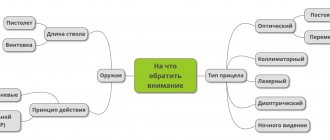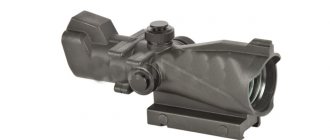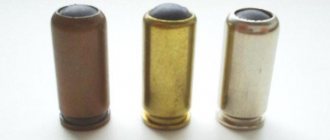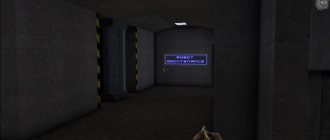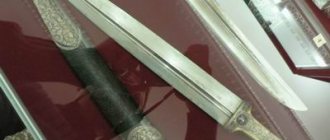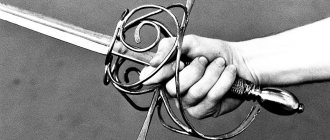What types of collimator sights are there?
Depending on the type of operation, collimator sights are divided into two types. Active collimators operate on batteries. The brightness of their aiming mark does not depend on the time of day. Passive sights require sufficient illumination. It is this that determines the glow of the brand.
Open
The device of any collimator includes a light source, a lens and a correction mechanism. Open red dot sights are simpler and more affordable. The lens (2) scatters light from the source (1), which is reflected from the inside of the input lens (3) and goes in a parallel beam towards the eye. As a result, the shooter sees the reticle and the target (4).
Features of open collimators:
- cannot be used during snow and rain, as they do not have protection from weather factors;
- have the function of changing the aiming mark;
- lighter and more compact than closed ones;
- provide sighting with two eyes;
- do not obscure the field of view.
Closed
The difference between closed type sights is the presence of protective glass (4) and a housing on both sides. The optical design is the same as that of open collimators. Protective glass protects the device from weather conditions and prevents dirt and moisture from penetrating inside.
Features of closed sights:
- in addition to the front lens, they have an eyepiece lens;
- due to the body, the aiming area is obscured;
- more dimensional;
- When installing an additional optical attachment, the magnification of the sight increases by 2 times.
Holographic
When deciding how to choose a collimator sight for a smooth-bore weapon, it is worth considering holographic models. Outwardly, they are similar to open sights, but have a different operating principle. A laser beam with a recorded image of the brand is emitted onto the photographic plate (1) from the reference radiation source. The result is its holographic projection (3). The image can also be obtained using a holographic grating (6) and a collimating reflector (5).
Features of such collimators:
- holography is better perceived by the human eye in daylight and night lighting;
- the brand is visible regardless of the degree of illumination;
- have virtually no parallax errors.
What is important for hunting
Good collimators for hunting smooth-bore and rifled weapons are produced by at least a dozen well-known optical companies. Sights with a different set of characteristics are sold, priced from thousands to tens of thousands of rubles. There are plenty to choose from, but a systematic approach is required. The hunter must understand his needs and determine what characteristics of the optics are responsible for them.
Selection for a specific weapon
There are no universal sights suitable for any weapon, for all occasions. But there are general criteria that are always important:
Caliber, recoil, shot energy, weapon shock loads . A collimator sight is a precise optical device that has its own safety margin. The recoil energy of a 12 gauge with a Magnum cartridge exceeds 4500 J, the impact load is more than 500g. If the scope is not designed for this, it will not last very long. The double recoil effect of pneumatic guns can destroy even military optics, while bows and crossbows have dangerous vibrations. It is very important.
Weapon balance and weight. If you need to mount a scope on a small caliber or vented rib rifle, weight may be critical. Usually collimators are not heavy and do not upset the balance, but the lighter the better.
Mounting type . Collimators are most often produced with a certain type of mount. It can be changed using an adapter, but this is always worse than the factory monolithic case with fastening. It is better to immediately purchase a suitable scope. Foreign weapons usually use Weaver/Picatinny rails, while popular models of Russian carbines are designed for side or top mounting on a dovetail receiver. In addition, there are adapters from a ventilated rail (to Weaver and Dovetail), as well as collimator sights, which are mounted directly on the ventilated rail, providing the lowest height of the aiming axis relative to the barrel, ease and reliability of fixation.
Passive and active devices
Air temperature is important. If the frost is below -40°, as in Russia, the batteries quickly run out and the sight stops working. Devices that do not require batteries are suitable for cold climates. They are sometimes called passive, as opposed to active, with a battery or accumulator.
Collimators "NPZ" produced by the Novosibirsk Instrument-Making Plant, which were developed for the needs of special forces, are passive. They use the glow of a phosphor under the influence of weak radiation from a tritium bulb.
Open and closed
Open type collimators have a higher viewing angle, but due to the fact that the LED is located in a horizontal plane, rain or snow may fall on it. Therefore, it is believed that these models are better for driven hunting. Due to the viewing angle, these scopes are preferable for hunting moving targets (fox, hare, duck). Closed ones, on the contrary, are more often used “from the approach”. True, many open models have protective visors, so the requirement is not strict.
There is an opinion on the Internet (but not among hunters) that an open red dot sight often gets dirty, and therefore it is recommended to use a closed one, which, due to its design, has a smaller viewing angle. This is true in heavy rain or heavy snow, but in such weather the point of hunting is lost. When choosing an open collimator, the hunter benefits from the versatility of using the sight - for moving targets and aiming speed.
Accuracy and parallax
Accuracy is the main characteristic of any scope. But optics always have parallax. This means that when the position of the eye changes, the aiming mark itself shifts slightly. The error of inexpensive collimator models is 1-2 arc minutes or 3-6 centimeters at a distance of 100 meters. This is imperceptible for smooth-bore weapons, but critical for rifled ones.
Open collimators have higher parallax than closed collimators - they are better suited for short distances. Holographic sights have no parallax at all due to their design.
Brand type and size
The aiming mark can be in the form of a dot, crosshairs, marks, and many models have a choice. Sizes are specified in minutes of arc, such as 1, 2 or 4 MOA. This means that at a distance of 100 meters the mark will cover three, six or twelve centimeters on the target. It is important that there is not too much compared to the goal.
Adjustment screws
Collimators are designed for shooting at point-blank range and usually do not require ballistic corrections. The adjustment screws are only needed for zeroing, but their convenience should not be neglected.
Planks and brackets
Most collimators are made in one piece along with the bracket. Such models can be quickly installed on an aiming bar. What other collimator mounts exist:
- "Dovetail". The simplest and most universal design of the seat for most shotguns. The design is simple and reliable, ensuring maximum service life. The mount is mounted on the zeroed place, so after installing the collimator there is no need for new zeroing.
- Picatinny rails with 0.394 inch pitch. You can move the installed device along the upper corrugated part, and thanks to the slots, you can fix it with levers or bolts in the right place. Thanks to the slots, the plank is lightweight and ventilated.
- Weaver rails with 0.18 inch pitch. This is an improved version of the dovetail with a more complex design. The bar is screwed along the entire length of the sight. It has an additional stop for adjusting the instability of the sight. Can be installed on pistols and sporting crossbows. Sights with Weaver mounts will also fit on Picatinny rails.
- Fastening via rings. They are designed for mounting a cylindrical sight. Most often included with the collimator.
Other types of sights for shotguns
Most likely, you no longer have doubts about the type of sight. And, despite the fact that the red dot sight is indeed better than others for all firing ranges from 12-gauge smoothbore weapons, for special cases other types of sights can be used, for example:
- laser or a combination of laser + collimator - for self-defense (at short distances, indoors);
- optical – for people with low vision, sports or amateur target shooting. In this case, we recommend using a driven sight, which combines the advantages of a red dot sight and an optical sight;
- night vision - obviously for use in the dark.
The article about choosing a collimator sight is quite extensive, and about other types of sights that can be installed on smooth-bore hunting rifles can be read in a separate article at the link. And here are our recommendations for choosing a night vision scope for 12 gauge.
Basic recommendations for selection and review of popular models
During the selection process, it is important to pay attention to the reticle. Personal preferences are allowed here. The classic version is a red dot. Today there are collimators with switchable brands, due to which they can be used on different types of weapons.
For shotguns, options with a circle-mesh have been developed. There are rice stamps, as well as color changing ones. Recommendations for choosing the type of red dot sight:
- Closed models are recommended for long-barreled weapons. Medium and large calibers are acceptable. Such scopes are chosen for hunting in densely populated areas and in difficult weather conditions.
- Open collimators are the optimal choice for small-caliber carbines and hunting in open spaces. The problem of contamination is solved very simply - buy protective caps for the eyepieces and lens. The sight is also cleaned regularly.
- Holographic models are recommended for installation on shotguns.
EOTech EXPS3-2
If you don’t know how to choose a red dot sight for a carbine, then be sure to pay attention to this model. It is recommended for installation specifically on light weapons: carbines, automatic and semi-automatic rifles. The cost of the device varies between 60,000-65,000 rubles.
The collimator is very accurate, allowing you to detect a target at a distance of 280 m. The model is distinguished by the absence of the parallax effect. Thanks to the complete impermeability and improved protection of the case, it can be submerged to a depth of 3 m. Compatible with night vision devices. To switch from day to night mode, the collimator has side buttons.
Aimpoint Micro H-1 Complete 2MOA
The Aimpoint Micro H-1 sight is designed for use with firearms, rifled or short-barreled. Also suitable for shotguns. Acceptable calibers are up to .500 Nitro Express. Due to its light weight, the collimator can be installed on lightweight weapons. Compatible with bows, crossbows and hunting revolvers. The sight costs about 30,000-36,000 rubles.
SightMark Laser Dual Short Sight collimator with laser center
Hunting scope equipped with an integrated laser target pointer. Users note that the device is suitable for hunting in a raid and from ambush, including from dense thickets. The sight can also be used for sporting weapons. Installing the SightMark Laser Dual helps solve the question of how to choose a red dot sight for 12 gauge. The model belongs to the budget category, since it costs 5000-8000 rubles.
How to choose
A 12-gauge smooth-bore gun is used mainly for hunting summer game (goose, duck) or large game (elk, wild boar). These are fast moving targets and in this case it is more convenient to hunt with a collimator sight mounted on the gun. However, as mentioned above, not all types can withstand recoil and, moreover, some models have additional capabilities, while others do not. So, when choosing a scope for 12 gauge, pay attention to the following points:
- Muzzle energy and recoil resistance. This parameter is always indicated in the scope's specifications.
- Optical design of the sight. Open sight - wider viewing angle, which will be an advantage at short distances, for shooting at moving targets. Closed - better protected and has less parallax.
- Changing the brightness of the aiming mark - the maximum brightness will “expose” the target, but in bright sunshine you cannot do without it.
- Sight weight.
Additional technical issues and questions can be clarified by contacting sales consultants in the store when choosing a model.
Comparative table of characteristics of red dot sights
To choose a suitable collimator model, you must study the main characteristics of all options. For ease of comparison, they are presented in the table:
| Characteristics | SightMark Laser | Aimpoint Micro H-1 Complete 2MOA | EOTech EXPS3-2 |
| Type | Open | Closed | Holographic |
| Lens | 33x24 mm | 21x15 mm | 33x23 mm |
| Working temperature | -10 to +50 °C | >From -30 to +60 °C | -40 to +65 °C |
| Mounting type | Weaver or Picatinny rail with 17-23 mm seat. | On the brackets. | On the Weaver bar. |
| Peculiarities |
|
|
|
| Weight, g | 162 | 105 | 317 |
| Power type | Can work for 2 hours with CR2032 lithium battery. | CR2032 batteries operate for up to 50,000 hours. | Operating time from one lithium battery is up to 600 hours. |
Share
The best driven optical sights
To paraphrase a well-known mnemonic, “every hunter wants to know which scope is best for driven hunting.” The peculiarity of this sport is that an animal raised from its rest may appear unexpectedly, and the hunter will not have time for careful aiming - the shot is fired immediately after aiming the weapon.
“Zagonniki” are installed on smooth-bore melee shotguns, sometimes on rifled carbines; the following requirements are imposed on the sights.
The minimum multiplicity is 1x. There should be a large image in the eyepiece, quick aiming is carried out with two open eyes, the aiming mark seems to be superimposed on the target. In fact, at close range the sight works like a collimator.
The maximum magnification is no more than 4x to hit game at a distance of up to 200 meters.
The reticle is simple: dot, duplex or stump. At short and medium distances, the distortion of the bullet trajectory is insignificant; there is no need to calculate corrections.
Lens diameter - the input lens can be small, about 20 mm, but the image in the eyepiece should be large, like on the screen, the usual diameter of the eyepieces is 40 mm.
Next is the rating of beater sights.
5pilads PV1-4x24L
Cost 8 Reliability 7 Functionality 8
The overall score is calculated as the average value of the sum of the main parameters.
7.7 Evaluation
pros
- Hinged glass covers
- Bright optics for dawn and twilight
- Reticle illumination
Minuses
- Low picture quality
- No mounting rings in the box
- High percentage of defects
The scope body is made in the form of a tube with a mounting diameter of 30 mm, there are no rings included, but the lenses are covered with hinged covers so they won’t get lost. Claimed to be protected from dust and splashes, immersion in water is not recommended.
Inside there is a 24 mm lens, coated to 80%; the end closest to the shooter expands, turning into an eyepiece with a diameter of 44 mm. On such a screen, the target is clearly visible at short and medium distances . The magnification ranges from 1 to 4x using a ribbed wheel.
The reticle is located in the focal plane of the eyepiece and does not change size with magnification. Designs vary - may be Mil-Dot, stump or crosshair. The L modification of the sight has a red backlight, the brightness is adjustable within 9 steps, and is powered by a CR2032 lithium cell.
Under the screw caps there are adjustment drums that rotate manually, but to set the scales to the zero position, you need a screwdriver.
4HAKKO BNL-1420 1-4X20
Cost 9 Reliability 8 Functionality 9
The overall score is calculated as the average value of the sum of the main parameters.
8.7 Evaluation
pros
- Lightweight aluminum body
- Good viewing angles
- Illuminated reticle
Minuses
- There are fakes on sale
- Correction drums on screws
- No mounting rings included
The sight is designed for offhand shooting from a small medium caliber at distances up to 100 m, image magnification is up to 4x. The minimum magnification of 1x allows you to aim with your eyes open, in which case the reticle is visually superimposed on the target.
The imperial standard 1" (25.4 mm) optical tube is made of aluminum and is protected from dust and raindrops. On one side there is a 20 mm lens, on the other there is an eyepiece with diopter adjustment and a ribbed rotating magnification ring. Eye relief is 80 mm from the glass.
The reticle is a crosshair with thick side and bottom lines; for evening hunting, the central dot is illuminated; the 11-step brightness control is located on the eyepiece; it is powered by a CR3020 battery. The adjustment flywheels are located on the top and sides, covered with screw caps.
3Nikon Monarch 7 IL 1-4×24
Cost 7 Reliability 10 Functionality 9
The overall score is calculated as the average value of the sum of the main parameters.
8.7 Evaluation
pros
- Fair minimum multiplicity
- Great picture in any conditions
- True waterproofing
Minuses
- Expensive branded item
- Heavy weight of the sight body
- Made in Philippines
The sealed Nikon tube can withstand 30 minutes in water at a depth of 1 m; there is nitrogen inside so that the lenses do not fog up. Mounting diameter - metric, for rings 30 mm; The scope weighs a lot - more than half a kilo, but allows you to shoot from a large caliber.
The magnification varies within 1-4x, without magnification the viewing angle exceeds 22 degrees, the sight can be used as a collimator, simply by sighting the target through the eyepiece - especially convenient at short distances (50-100 m). The eye relief is 95 mm, excellent for safe shooting.
Multi-layer coating provides up to 95% light output - hunting will take place at any time of the day. For greater comfort, the aiming mark is illuminated - red and green colors are set, as well as brightness - as many as 32 steps, selected for any conditions.
The adjustment handwheels are covered with screw caps, can be adjusted easily and clearly, and have a quick zero setting that does not require tools.
2Hawke Endurance 30 WA 1-4×24
Cost 8 Reliability 9 Functionality 8
The overall score is calculated as the average value of the sum of the main parameters.
8.3 Evaluation
pros
- Good viewing angle
- Bright optics
- Hinged protective covers
Minuses
- Few brightness adjustments
- It is difficult to enter corrections into the field
- The sight makes the weapon heavier
The sight casing is machined from a solid aluminum tube, sealed and filled with dry nitrogen—precipitation and temperature changes are not a problem. The mounting diameter is 30 mm for rings, the objective is 24 mm, the eyepiece expands to 44 mm, which gives a wide field of view, about 18 degrees.
The best use for optics is shooting at short and medium distances; the sight can withstand the recoil of a 7.62 mm cartridge . The magnification ranges from 1 to 4x using a rubberized zoom ring located in front of the eyepiece. It’s convenient that the lenses are protected by hinged metal covers, no rubber bands - they won’t get lost or scratched.
Lateral corrections are introduced by drums under screw casings, rotated by hand, and there is a slot for a coin for fixation.
The aiming marker of three marks is located in the second focal plane and does not change size with magnification. For hunting at dusk, it is illuminated in red, the brightness changes in 6 steps.
1YUKON Jaeger 1-4×24
Cost 9 Reliability 8 Functionality 9
The overall score is calculated as the average value of the sum of the main parameters.
8.7 Evaluation
pros
- Excellent field of view at minimum
- Convenient multiplicity adjustment ring
- Good impact resistance
Minuses
- Rare backlight battery
- Fine thread flywheel covers
The sight body is machined from a single piece of aluminum, this treatment gives excellent rigidity - it holds recoil up to 7000 J from a large caliber or smoothbore. The scope is IPX7 certified (short-term immersion 1 m), sealed and gas-filled.
The tube is designed for 30 mm rings, the 24 mm lens closer to the shooter goes into a long eyepiece body (43 mm). Thanks to this solution, adjusting the magnification is very convenient when wearing gloves; the rubberized guidance ring is wide. The magnification is 1-4x, at minimum the view is very large - 21 degrees, any game will fit.
Reticle - HB01i - horizon and vertical mark on the side of the lower quadrants, the crosshair is illuminated. Unlike most competitors, the brightness control is placed next to the adjustment drums, improving the weight distribution of the sight. A long-lasting but rare CR2354 battery is used for power supply.
The adjustment flywheels are hidden under covers, rotate clearly, and are spring-loaded for quick reset to zero. But the threads on the covers are very thin and can easily be damaged.
Holosun Open Reflex
The Chinese panoramic collimator allows you to aim with two eyes. Installed on hunting shotguns. The backlight is powered by two power sources - a solar battery and a regular disk battery.
Main characteristics of the collimator sight:
- open;
- 9.1 cm;
- 264 g;
- 32 x 24 mm (lens);
- 3 aiming marks;
- 2MOA;
- dual power supply - CR2032 + built-in solar battery;
- Picatinny (Weaver);
- $490.
Pros:
- NVD compatible;
- low energy consumption;
- adjustable brightness (12 levels);
- reticle illumination;
- memory saving function;
- sleep mode.
Minuses:
- no magnification;
- only for shooting at nearby objects;
- cannot see in the dark;
- Not recommended for use in adverse weather conditions.
VOMZ AVIS PC 1x20 military
The Russian 1x20 Avis collimator sight is designed for medium-caliber hunting rifles. Used for aiming at stationary and moving targets. Works in any lighting (daytime and twilight). Does not have the properties of a thermal imager (does not see an object in the dark).
Description:
- closed;
- 6.7 cm;
- 196 grams;
- 20 mm lens;
- 1x (multiplicity);
- Picatinny (Weaver);
- 2MOA dot;
- $150 (cost).
Advantages:
- red backlight;
- withstands shock loads of 800 g;
- backlight adjustment.
Flaws:
- only at close range;
- no thermal imager properties;
- no magnification.
ZENIT PKM 125 without fastening
Inexpensive Russian sight. Used for hunting rifles model IZH-58 (16 gauge) and carbines “Tiger”, “Saiga”, “Vepr” and “Los-7”. Suitable for shooting at standing and moving objects.
Description:
- closed;
- 25mm lens;
- 1x magnification;
- 3 types of reticle (4MOA, stump, stump with dot);
- 112 x 56 x 68 mm;
- 300 g;
- element SR 2430;
- 80 dollars.
Pros:
- brand adjustment;
- precise alignment mechanism;
- backlight
Minuses:
- weak increase;
- cannot see the target in complete darkness;
- mechanical adjustment (no automatic).
Hawke R.D.
The collimator of the English brand Hawke is installed on a shotgun or air gun. The device provides high aiming accuracy at close ranges.
Peculiarities:
- closed;
- 30mm lens;
- 13 cm;
- 162 grams;
- 4MOA;
- red stamp;
- Weaver/Picatinny;
- CR2032;
- 50 dollars.
Pros:
- backlight;
- adjustable brightness (11 levels);
Minuses:
- no magnification;
- no thermal imager properties;
- only for close aiming.
Holosun Paralow
Collimator sight from the Chinese brand Holosun. The compact device (with a red dot) is installed on hunting rifles, pistols, and air rifles.
Description:
- closed;
- 6.3 cm;
- 124 grams;
- 22 mm lens;
- 2MOA dot;
- 1x magnification;
- CR2032 battery;
- Picatinny (Weaver);
- 300 dollars.
Advantages:
- NVD compatible;
- backlight;
- 10 brightness levels.
Flaws:
- does not serve to increase;
- cannot see an object in complete darkness;
- only for close aiming.
Vortex Sparc AR
A well-deserved place in the ranking of the best red dot sights is occupied by the Sparc AR device from the Japanese brand Vortex. Fits AR-15 model weapons.
Main characteristics:
- closed;
- 74 mm (length);
- 213 g (weight);
- Weaver mount;
- 2 MOA dot (reticle type);
- 22 mm (lens diameter);
- 1 AAA battery (power);
- 1x (multiplicity);
- $250 (price).
Pros:
- backlight;
- backlight adjustment;
- wide range of corrections.
Minuses:
- not used with VMX-3T Magnifer;
- only at close distances;
- no thermal imager properties;
- does not increase.
Sightmark Ultra Shot
Collimator for rifled and smooth-bore weapons of any caliber. Allows you to aim at stationary and running objects.
Characteristics of the collimator sight:
- open;
- 34x25 or 33x24 mm (lens);
- 9-11 cm;
- 170-303 g;
- red stamp (in some models additionally green);
- 4 types of aiming reticles;
- 3MOA, 5MOA, 10MOA;
- CR1620 or CR123A;
- Weaver/Picatinny;
- 200 dollars.
Pros:
- adjustable brightness;
- choice of aiming mark;
- reticle illumination.
Minuses:
- no magnification;
- for close aiming;
- no thermal imager properties.
Marcool ACOG 1X40
The ACOG 1X40 model from the Chinese company Marcool takes a well-deserved place in the list of the best budget red dot sights for playing airsoft. The device is not used for hunting.
Peculiarities:
- closed;
- 42 mm;
- 90 grams;
- lithium CR1620;
- RIS-bar;
- $75 (price).
Pros:
- red or green reticle;
- 5 brightness modes.
Minuses:
- not installed on hunting rifles (will not withstand severe recoil);
- only for playing airsoft.
SIGHTMARK SM13003B-DT 1 X 33-24, open
Collimator of American brand and Chinese production. Installed on sporting, hunting weapons and even .50 caliber rifles. Allows you to aim at stationary and moving objects. Suitable for offhand shooting.
Sight description:
- open;
- 33 x 24 mm lens;
- 8.2 cm;
- 119 grams;
- 4 types of reticle;
- 3MOA, 5MOA;
- dovetail;
- CR2032;
- red stamp;
- 130 dollars.
Advantages:
- sensitive correction mechanism;
- brightness control (7 levels).
Flaws:
- no magnification;
- for aiming at distances up to 35 meters;
- not compatible with NVGs;
- can't see in the dark.

